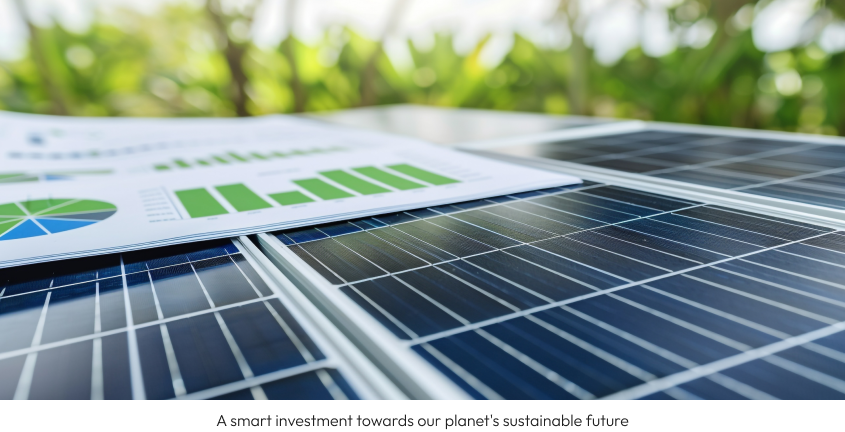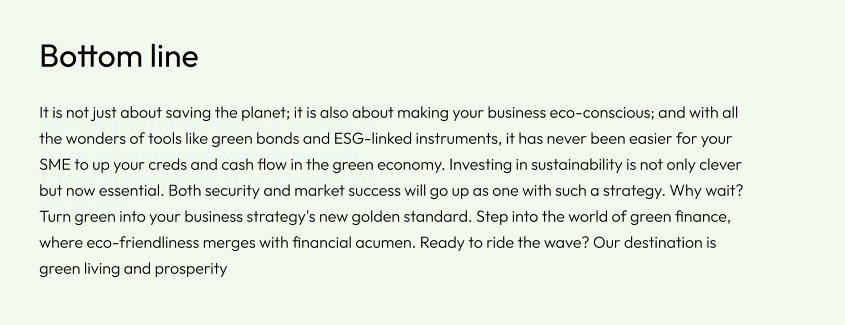Today the shift to the green line is not only a moralistic choice; it is also an economic imperative. Welcome to the green frontier, where small and medium enterprises (SMEs) are not just part of the backbone of the world economy; they are also activists in tackling climate change. Across the world, SMEs represent 90% of the businesses, 60 to 70% of employment, and 50% of the GDP. It is only paramount to think of the hefty footprint they leave on the environment.
To tackle the problem of carbon footprints at a global stage, green bonds, green loans, and ESG-linked instruments for SMEs offer significant benefits from lower costs to expanded market access without causing any harm to the environment. There is no better time to start than right now — and with flexible tools provided by governments and financiers, you can be both profitable and sustainable.
Sounds exciting? Join the sustainability bandwagon now and explore the myriad ways in which your SME can use green financing and enable the green economy future where ‘sustainable is attainable.’
What is green financing?
Green financing covers financial instruments whose aim is to achieve higher environmental value, such as renewable energy projects, pollution control, environmental restoration, etc. These financial stocks consist of loans, investment funds and environmental bonds which underpin "green" projects. This approach is crucial for the shift to a low carbon sustainable economy, as it requires choices on investment that meet environmental needs and involvement by the public sector in green projects in partnership with private actors.
Moreover, green finance is regarded as key to the world's strategy in relation to meeting Sustainable development goals (SDGs). In short, it involves ensuring that financial flows are all subject to earth protection and sensitive to the environment. Various measures used to affect this alignment include providing a legal framework for regulating development that is sustainable, expanding green bond projects and promoting public-private cooperation aiming at environmental sustainability.

Green instruments to meet SME financing need
Green loans
Green loans are used to finance projects that care to prevent environmental issues such as climate change, soil pollution, natural resources depletion, the loss of biodiversity, and many others. Borrowers are obliged to report on the usage of such funds, including the impact of funds spent, like emission reduction, energy saved or produced, etc. Banks and PFIs provide green loans at concessional terms and have lower interest rates and terms compared to the market terms. Green credit guarantees are meant to support private lending to small and medium enterprises depending on environmental targets or impacts and monitoring only the performance.
Green bridge loans
These loans serve as interim financial support for SMEs, enabling them to bridge gaps to more stable financing solutions. They are particularly beneficial for early-stage companies in the green sector, who face significant upfront costs and risks while developing innovative technologies in clean energy or sustainable transportation.
Green bonds
Green bonds refer to debt instruments intended only to be used for environmental-friendly projects or in combating climate change. Only bigger and more prominent SMEs could issue their green bonds, but smaller ones can still be linked through bigger financial entities issuing these bonds to fund smaller projects. Mini bonds could be more proper for a green startup or a small-scale SME, as they grant a higher yield thanks to being non-tradeable, meaning they need to be held to their maturity because there is no secondary market for them.
Revolving credit
Revolving credit is a financial policy that enables green SMEs to borrow and repay an equivalent amount of the borrowed amount. The marketing source is used to support loans for projects such as energy savings and renewable power, which diminish expenditure. A fraction of the cost savings is also reinvested in the loan to fund further similar projects.
Hybrid financing instruments
The instruments help PFIs enhance the incentives awarded to SMEs that are seeking to make the transition to green, at times leading to more attractive green investment options than regular financing can achieve. A common factor is turning part of a green loan into a grant whenever the SMEs decide to invest in environmental and climate change projects such as renewable energy projects or energy efficiency.
ESG-linked instruments
ESG-linked financial instruments including loans and bonds reset terms depending on the issuer’s success in sustainability. In this sense, ESG-linked loans reset interest rates, depending on certain sustainability measures, i.e., carbon emissions. ESG-linked bonds reset coupon rates depending on targets as determined by a framework, which can be an environmental performance, such as the EU (European Union) Taxonomy or UNSDGs.
Green finance platform and bonds
The Small Industrial Development Bank of India (SIDBI) manages the green finance platform, leveraging its high credit rating and accreditation with the Green Climate Fund. This platform provides MSMEs with access to green bonds and loans, offering better terms and reduced risks through a credit enhancement mechanism, modeled on the existing Credit Guarantee Fund Trust for Micro and Small Enterprises. To cement this further, SIDBI partnered with Tata Power to provide affordable and collateral-free financing for rooftop solar for MSME consumers.
Green loan principles
Alongside renewable energies, green loans should further environmental sustainability. In particular, the projects funded can include measures to stop air pollution; preservation of animals and plants in their natural habitats (biodiversity conservation); and adaptation against climate changes. Its undertakings must be in line with certain guidelines to gain an investor’s confidence that their financing benefits the environment.

Government policies and budget initiatives
The Green Credit Programme was officially initiated in India in October 2023. It is a market-oriented approach designed to stimulate voluntary environmental activities in a wide range of sectors, including individuals, communities, and private enterprises. The program is part of the overall “Lifestyle for Environment” initiative supported by the Indian government.
The participants here can receive ‘Green Credits’ for creating and taking part in activities that contribute positively to the environment, such as saving water and reforestation. They can be exchanged on a specific platform, processed via the government-based digital tool, and verified. The premise of this example is to help conserve the environment and aid the creation of a market for ecological businesses and customer behavior.
International and domestic collaboration
To help the country transition into a green economy, India has been working extensively with many stakeholders, such as multi-lateral development banks and private investors and public institutions. The Green Climate Fund Readiness Programme and various public-private partnerships together aim to leverage finance and technical capability for green projects in India.
Emergency Credit Line Guarantee Scheme (ECLGS)
This major scheme offers loans without collateral with the support of a government guarantee, giving some means of coping to MSMEs during an economic downturn. The ECLGS has been particularly important in making it such that small and medium sized enterprises (SMEs) can still survive even though facing financial difficulties.
Market access and expansion
To help small and medium enterprises reach a greater scale and enter new markets, the Indian government has established platforms such as the MSME Champions Portal. This program will aid small and medium enterprises in exploring both new domestic international places of business; crucial for development.
Skill development and training
Characteristically, the Indian government prioritizes skill development to enhance MSMEs’ competitiveness. For example, the Pradhan Mantri Kaushal Vikas Yojana envisions industry-relevant short-term training to upskill youths and MSME employees. In particular, the sectoral requirements are being met by the Tool Rooms and Technology Development Centers of the MSME Ministry which offer specialized training in aspects such as CAD/CAM, precision machining, and automation. Therefore, the programs are aimed at increased productivity and flexibility and responsive operations by MSME workers who are empowered with enhanced technical knowledge appropriate to the nature of business today.

Keep reading...
View all







